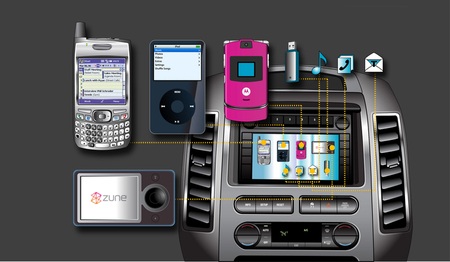By: Jeffrey Lapin
 On February 16, 2012, U.S. Department of Transportation (DOT) Secretary Ray LaHood announced the first-ever federally proposed guidelines to encourage automobile manufacturers to limit the distraction risks posed by in-vehicle electronics. The guidelines, which would be voluntary, would apply to most non-commercial vehicles. The goal is to limit the number of injuries and deaths caused by a driver distracted by in-vehicle electronics.
On February 16, 2012, U.S. Department of Transportation (DOT) Secretary Ray LaHood announced the first-ever federally proposed guidelines to encourage automobile manufacturers to limit the distraction risks posed by in-vehicle electronics. The guidelines, which would be voluntary, would apply to most non-commercial vehicles. The goal is to limit the number of injuries and deaths caused by a driver distracted by in-vehicle electronics.
ANNOUNCEMENT AND SCOPE OF GUIDELINES
In announcing these new Guidelines Secretary LaHood stated, “Distracted driving is a dangerous and deadly habit on America’s roadways – that’s why I’ve made it a priority to encourage people to stay focused behind the wheel.” These guidelines are a major step forward in identifying real solutions to tackle the issue of distracted driving for drivers of all ages.
The guidelines, which would be voluntary, would apply to any communication, entertainment, information gathering or navigation devices or functions that are not required for a driver to safely operate a car, SUV, pickup truck, minivan and other vehicles rated at not more than 10,000 pounds gross vehicle weight. However, they would not affect conventional controls and displays, such as heating, air conditioning, instrument gauges, because these are considered a “primary driving task.” In addition, they are not intended to limit collision warnings or vehicle control systems, which are designed to aid the driver in controlling a vehicle and avoid crashes.
THE PROPOSED GUIDELINES
The proposed Phase I distraction guidelines include recommendations to automakers to:
- Reduce complexity and task length required by the device;
- Limit device operation to one hand only (leaving the other hand to remain on the steering wheel to control the vehicle);
- Limit individual off-road glances required for device operation to no more than two seconds in duration;
- Limit unnecessary visual information in the driver’s field of view; and
- Limit the amount of manual inputs required for device operation.
The DOT Guidelines would request vehicle manufacturers to prevent drivers from using certain in-vehicle equipment, while driving, that are believed to so distracting that they could effect a driver’s ability to safely control a vehicle. The list of tasks that are believed to so distracting include:
- Displaying images or video not related to driving;
- Displaying automatically scrolling text;
- Requiring manual text entry of more than six button or key presses during a single task; or
- Requiring reading more than 30 characters of text (not counting punctuation marks).
Limiting these items would help reduce or prevent many of the driver distractions created by newer technology such as text messaging, internet browsing, social media browsing; navigation system destination entry by address and manually 10-digit phone dialing. The Phase I Guidelines are intended to limit visual tasks for factory installed equipment; those tasks that could be done by voice or sound would presumably not be effected nor would after-market or portable devices.
The full Guidelines, Visual-Manual NHTSA Driver Distraction Guidelines for In-Vehicle Electronic Devices, are available here or on the Department of Transportation’s website (www.dot.gov).
FUTURE GUIDELINES
The DOT and the National Highway Traffic Safety Administration (NHTSA) are considering additional guidelines to address items not covered by Phase I. Phase II proposed guidelines may address devices or systems that are not built into the vehicle but are brought into the vehicle and used while driving, including aftermarket and portable personal electronic devices such as navigation systems, smart phones, electronic tablets and pads, and other mobile communications devices. Phase III would consider voice-activated controls to further minimize distraction in factory-installed, aftermarket, and portable devices.
CONCLUSION
These proposals are a good first step in trying to limit driver distraction. Distracted driving caused at least 3,092 deaths in 2010. However, it is important to remember these even those tasks that would not be affected still can lead to driver distraction, accident, injuries and death. The guidelines merely attempt to limit the “length” of the distraction. In addition, these are just guidelines; automakers would not be required to abide by them. Drivers need to remember their only job is to drive and make sure everyone gets to their destinations safely.
OTHER DRIVING RELATED POSTS
- Bill Would Limit Liability in Escaped Cow- Vehicle Collisions
- Drivers Prepare: Winter Weather Is Arriving Soon
- Drivers: Beware of Deer
- Drivers Understand But Often Ignore Risks of Texting or Talking on Cell Phone
- Distracted Driving: Risks Inside Your New Car or Truck
ABOUT LAPIN LAW OFFICES
 Lapin Law Offices represents drivers and passengers involved in all types of motor vehicle collisions. If you have been injured please give us a call at 402-421-8033 (24/7) or contact us through our website, LapinLawOffices.com, for a free initial consultation.
Lapin Law Offices represents drivers and passengers involved in all types of motor vehicle collisions. If you have been injured please give us a call at 402-421-8033 (24/7) or contact us through our website, LapinLawOffices.com, for a free initial consultation.

